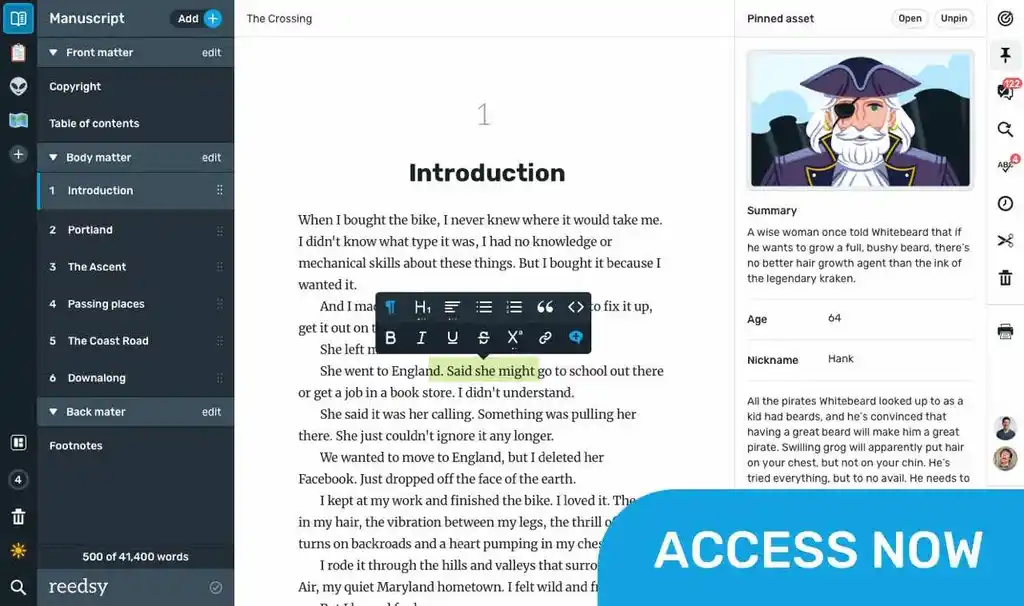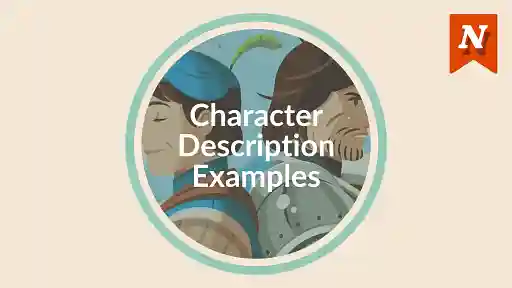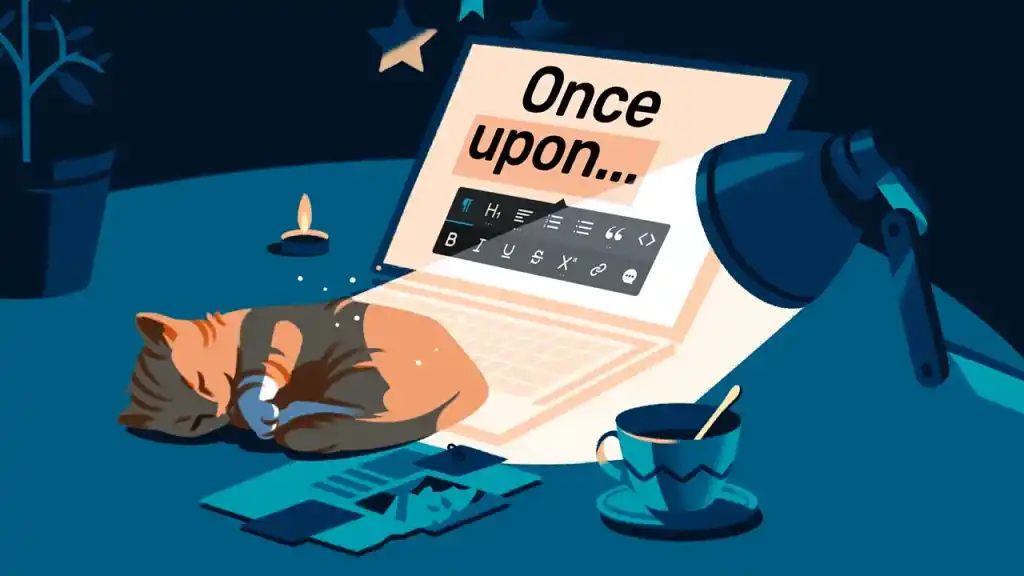When it comes to storytelling, a character’s face is more than just a collection of physical features — it can show their emotions, personality, and even their history. Consider Hercule Poirot, whose perfectly groomed mustache reflects his obsessive attention to detail. Or think of Captain Ahab, whose intense gaze and weathered, tired face emphasize his fixation with hunting Moby Dick at any cost.
How do you describe characters that leap off the page like Poirot and Ahab do? In this post, we’ll go beyond surface-level descriptions and explore advanced techniques for writing about characters’ faces, with practical tips and examples that will help bring them to life.
1. Add depth to basic features
A well-described face can immediately give readers a sense of who a character is, creating a deeper emotional connection and making them feel more alive and relatable. Every feature, whether it’s a subtle wrinkle or a slight curve of a mouth, can carry meaning.
That's not to say you should describe every eyelash and pore! All I'm suggesting is to strike a balance between physical description and emotional resonance — which means taking the time to consider how facial features might reveal something meaningful about your character. Let’s consider these four key features:
👀 Eyes
Eyes are often called the window to the soul, and for good reason. With just a quick glance, they can reveal a character's emotions, mood, or even hidden intentions.
🔖 Example: Her eyes grew so dark they seemed almost black. They were hard and distant, even when she spoke.
This description shows how a character's eyes can reveal emotional distance and guardedness. The lack of warmth and the hardness in this character’s gaze immediately signal that something is off, drawing readers in to wonder what she’s hiding or protecting herself from.
Other elements to consider:
-
How the light reflects in the eyes (or doesn't)
-
Changes in dilation based on emotion
-
Movement patterns (darting, steady, avoiding contact)
-
Lines and details around the eyes (crow's feet, dark circles)
Overall, don’t just focus on eye color or shape. Pay attention to how a character’s eyes change depending on what’s going on. Do they soften when they’re calm? Narrow when they’re upset? These little shifts can divulge what’s really going on inside, making your character feel more real.
👄 Mouth
The mouth is one of the most expressive parts of the face. Whether it’s a warm grin or an awkward, fake smile, the way a character's mouth moves can hint at who they are and what’s lurking beneath the surface.
🔖 Example: Her thin lips twitched, but she didn’t say anything.
This subtle movement in the character’s mouth suggests a suppressed reaction or unspoken thought, making readers wonder what she’s internally struggling with.
Other elements to consider:
-
Natural position when relaxed (pursed, slightly open, firmly closed)
-
Smile quality (reaching the eyes or not, lopsided, brief)
-
Habits related to the mouth (biting lips, licking them when nervous)
-
Tension patterns (clenched jaw, grinding teeth)
Describe not just mouth shape, but also changes in the mouth — like a forced smile or lips pressed together to hint that a character is holding something back, or a huge grin that spreads uncontrollably to show genuine excitement.
👃 Nose
Noses play an important role in shaping how we envision a character. Certain traits of the nose — sharp, delicate, large, small — can add dimension to a character’s overall look.
🔖 Example: His long, sharp nose seemed to cut through the air whenever he walked into a room.
This description highlights the character’s nose as a distinct, almost commanding feature. It suggests a sense of authority or dominance, and immediately gives readers an impression of the character's presence.
Other elements to consider:
-
How the nose fits with other facial features (dominates or blends)
-
Any marks, scars, or distinctive elements (broken nose, freckles)
-
Cultural or family significance (a “family nose” passed down generations)
-
How it contributes to overall expression (flaring nostrils when angry)
Use the shape or size of a character’s nose to add layers to their personality, like making them seem assertive or more reserved. You can hint at traits like confidence, arrogance, and even innocence depending on how the nose stands out or blends in with the rest of their face.
✋ Skin
The texture, condition, and tone of a character’s skin can reveal a lot about their lifestyle, health, and background. Whether it’s smooth and unblemished or creased and weathered, skin can help tell a character's story in just a few words.
🔖 Example: Her skin was deeply tanned and wrinkled after years of work.
This description quickly paints a picture of someone who’s spent a lot of time outdoors. Readers can see that this character works hard and probably comes from a more down-to-earth background, giving a sense of who they are without spelling it out.
Other elements to consider:
-
Signs of aging or youth
-
Marks that hint at past experiences (scars, laugh lines, worry creases)
-
Coloration changes during emotional moments (flushing, paling)
-
Overall health indicators (pallor, ruddiness, glow)
Consider how a character’s skin shows their life experiences. Is their skin soft and flawless, suggesting they’ve had an easy life? Or perhaps their skin is rough and marked by years of hard work, giving you a sense of their no-nonsense attitude? Let their skin tell the story.
2. Employ figurative language to show emotions
Metaphors, similes, and other types of figurative language are powerful tools for conveying feelings without directly naming them. You don’t have to tell your readers that a character is sad or happy — let their features show it.
Let’s dive into how comparisons and a bit of sensory detail can really make a difference:
Emotion through comparison
Figurative language allows readers to grasp a character's emotional state by connecting it to something familiar and evocative. Rather than plainly stating that a character is feeling a certain kind of way, comparisons create a more visceral understanding.
🔖 Example: His eyes were gray and brooding, like a storm about to break.
This description uses a simile to create a sense of tension, suggesting the character’s intense emotional state without explicitly saying so. The stormy eyes hint at the character’s mood — unpredictable, possibly troubled — giving readers a better understanding of his inner world.
Consider these questions:
-
What natural elements (weather, landscape, seasons) might mirror your character's emotional state?
-
What animals share characteristics with your character's expressions or mannerisms?
-
How might everyday objects take on new meaning when used to describe facial features?
Think of creative ways to show what’s beneath the surface of a character’s face. For example, describe a character’s smile as “a crack in a wall,” suggesting that their friendliness is fragile or forced. Or, instead of saying someone has a “sharp gaze,” you might write: “Her eyes cut through weakness like scissors through tissue paper.” This not only conveys intensity, but also suggests precision and perhaps a touch of ruthlessness.
Sensory elements
Figurative language becomes even more powerful when it engages multiple senses, creating a richer, more immersive experience for your readers.
🔖 Example: His lips were cracked leather.
This metaphor conveys more than just physical dryness; it also suggests a sense of weariness, neglect, or even emotional numbness. Readers can almost feel the rough texture themselves, creating immediate sensory empathy with the character.
Consider these sensory-rich approaches:
-
Texture: “Her smile was smooth as polished stone” (suggests something beautiful but perhaps cold or unfeeling)
-
Temperature: “Cold sweat beaded on his forehead like morning dew on winter grass” (conveys fear with a vivid, tactile image)
-
Sound: “Her voice was the whisper of pages turning in an empty room” (suggests both quietness and perhaps loneliness)
-
Taste: “His mouth tightened as though he'd sunk his teeth into unripe fruit” (conveys resentment through gustatory imagery)
Use figurative language to make your character’s physical details mirror their emotional state. For example, describing a character’s mouth as being “like a tightly drawn bow” could hint at suppressed feelings or tension. Or if their skin feels “paper-thin,” this could reflect vulnerability or fragility.
Remember, the best figurative language doesn't call attention to itself — it simply makes characters feel more real. When readers forget they're reading descriptions and instead feel as though they're meeting a living, breathing person, you'll know your figurative language is working its magic!
3. Use original wording instead of overused phrases
When describing faces, it can be easy to fall into a few traps that might make your characters feel stale or unmemorable. But with a bit of creativity and awareness of these pitfalls, you can craft descriptions that not only help readers visualize your characters, but also reveal something meaningful about who they are. Here are the major pitfalls I think every writer should try to steer clear of:
Clichéd phrasing
You’ve probably come across phrases like “sparkling eyes” or “perfectly sculpted features” a million times. While they might sound nice, they don’t really reveal anything about who the character is. Because these descriptions are so overused, they end up feeling predictable and flat.
💡How to avoid it: Be more specific about something that actually illustrates the character’s emotions or personality. For example, instead of saying “Her eyes were sparkling,” try “Her eyes gleamed with a mischievous spark, as if she knew something no one else did.” This not only paints a more vivid picture but also offers a real glimpse into her mood and character.
-
“Chiseled jawline”
-
“Chocolate brown eyes”
-
“Full, pouty lips”
-
“Heart-shaped face”
-
“Perfectly arched eyebrows”
These descriptions might be accurate, but they don't add any unique dimensions to your character. They're like the literary equivalent of stock photos — generic and forgettable.
Physical stereotypes
It’s tempting to rely on stereotypes — like the “brooding bad boy” with sharp features or the “flawless beauty” with perfectly symmetrical everything. But the problem with stereotypes is they don’t show us what makes a character unique. They won’t help your readers understand what makes a character special, or how their face reflects who they truly are.
💡How to avoid it: Instead of relying on common archetypes, dive into their individual background or life experiences to craft a more original description. For example, instead of saying “She was a classic beauty with a shy smile,” try something like “Her smile was crooked and shy, hinting at years of hiding behind the camera.”
More stereotypical descriptions to avoid:
-
The villain with a facial scar
-
The nerd with thick glasses and awkward expressions
-
The femme fatale with plump lips and sultry eyes
-
The wise elder with a weathered face and knowing eyes
Remember, real people are complex and contradictory — your characters should be too. A tough-looking character could have surprisingly gentle eyes, while a character with a boyish face might be hiding a calculating mind.
Bringing a character’s face to life goes beyond mere physical traits — it’s about using those details to reveal their true nature. By applying the tips and techniques we’ve covered, you'll soon be creating characters that readers can actually see in their mind's eye.
Remember, your goal isn't to create a police sketch of your character, but to give readers just enough details that they can fill in the rest with their imagination. When you strike this balance, your characters will step off the page and into your readers' hearts and minds.












Brilliant article! Your post reminds me 13 wonderful and extremely useful tips from Chuck Palahniuk that I've recently read ( https://litreactor.com/essays/chuck-palahniuk/stocking-stuffers-13-writing-tips-from-chuck-palahniuk ). Thanks for your precious advice.
Selena - Over 9 years ago
Thanks, Selena! Sorry for the delayed response, Disqus didn't give me a notification for some reason. Love Chuck Palahniuk's words on writing, thanks for sharing.
Bridget At Now Novel - Over 9 years ago
I am from Brazil and love your blog.
Bruna Araujo - Over 8 years ago
Thank you, Bruna! Thanks for reading.
Bridget At Now Novel - Over 8 years ago
Thanks for this! and good ideas.
Swizzili - Almost 8 years ago
It's a pleasure! Keep writing.
Bridget At Now Novel - Almost 8 years ago
My name is Kersten Fitzpatrick, I am a fantasy writer, but I am having trouble putting my characters onto paper. I do good stories but putting my characters onto paper is really hard
Kersten Fitzpatrick - Over 7 years ago
very nice and useful article
Gauri Shanbhag Wagle - About 7 years ago
As a student that loves to write and do his best in everything possible while having to bother as little people as possible this article along with many others have been extremely helpful and am so appreciative that the articles contain accurate and useful information but it is also short so that I can read it without having to worry too much with the time it would take me to learn. Thank you!
Awesome Gaming - About 6 years ago
Thanks for your kind feedback, we're glad to help and that you're enjoying our articles. It's a pleasure. Good luck with your studies!
Jordan At Now Novel - About 6 years ago
Very useful guid! It really helped me to write ideas in my novel! =)
A.J. Mc Mahon - Over 5 years ago
Thank you for this feedback, A.J.! We're glad you found it helpful.
Jordan At Now Novel - Over 5 years ago
Boring do better kidding .This was excellent
Brooklyn - Over 4 years ago
Haha, ouch, Brooklyn. I'm glad it was helpful, thanks for your feedback.
Jordan - Over 4 years ago
This was really amusing to me and I learnt true things from this. Thank you.
Goodness - About 4 years ago
It's a pleasure, Goodness. Thank you for reading our articles and taking the time to share your feedback.
Jordan - About 4 years ago